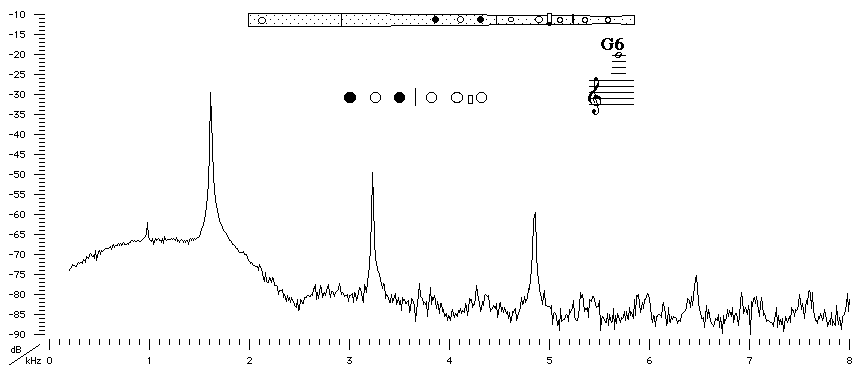| Acoustics of baroque, classical and modern flutes |
classical flute
|
G6 |

|
Acoustic and Fingering Schematic Non-specialist introduction
to acoustic impedance |
This fingering is comparable to that for G4 except for
the use of the LH 2nd finger as a register
hole. This creates a pressure node (or flow antinode) about three quarters
of the way along the pipe, and thus allows G6 but not G4, G5, or D6. Comparing
this with the G4 impedance spectrum, we see that the fourth
minimum is little changed. The third is shallower and unplayable. The first
minimum plays ~B4 and the second ~B![]() 5
but, because it is a cross fingering for these notes, their timbres are darker.
5
but, because it is a cross fingering for these notes, their timbres are darker.
This fingering is out of tune - classical flutes intended to play in the third octave usually had extra keys, which allowed the designer more parameters to vary to maintain intonation over a wider range. The player was asked to play the fingerings 'where they were', rather than to tune them by varying the coverage of the embouchure hole. (The dimensions of the instrument are based on those of a large-hole Rudall and Rose flute: R & R #655 from the Bate Collection in Oxford.)

Sound spectrum
of a classical flute with a flared foot played using fingering for G6.
![]()
![]()
![]()
![]()
![]() You can hear G6
played by Geoffrey Collins.
You can hear G6
played by Geoffrey Collins.
| Acoustic measurements are available for these flutes - modern B, modern C, classical C, classical D, classical flared, baroque Sound clips are available for modern B, classical flared and baroque |
To compare flutes, it is easiest to open a separate browser window for each instrument. |